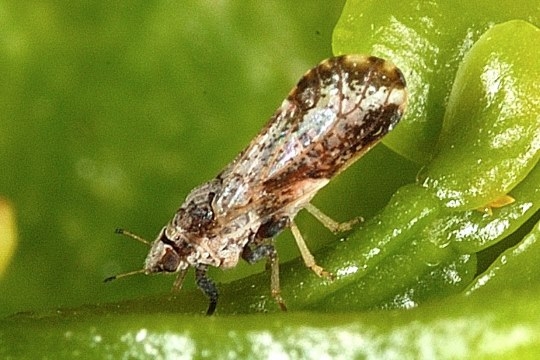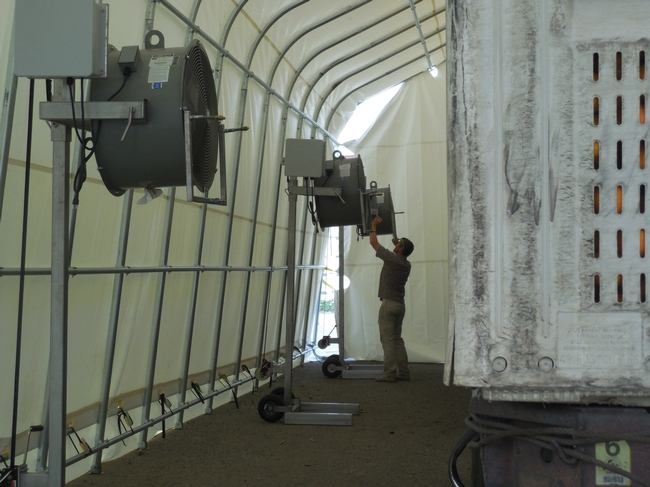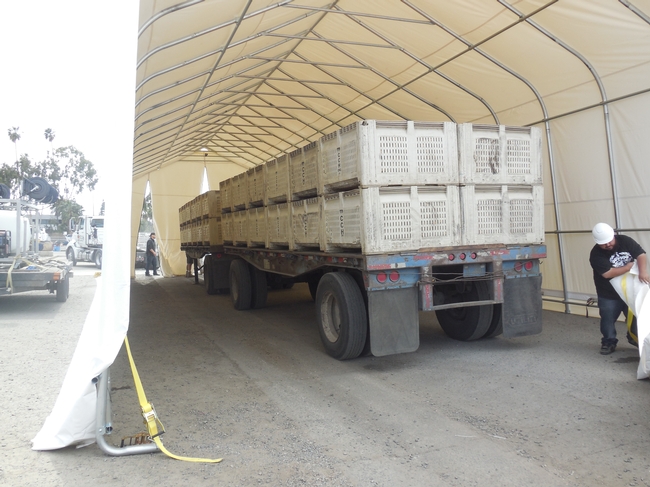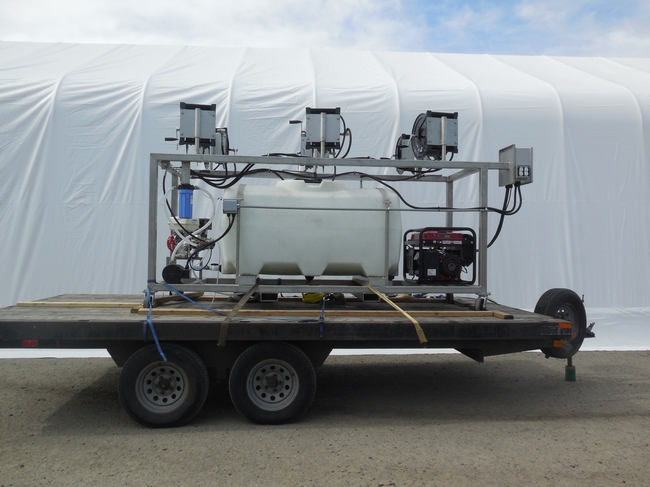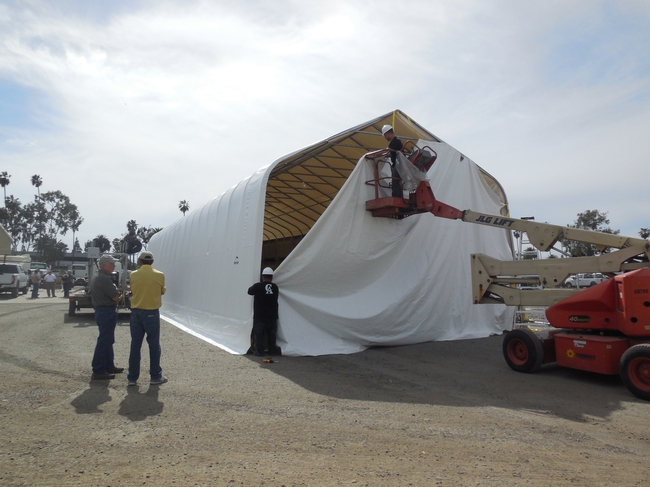
Posts Tagged: research
Avocado Orchard Research - Your Way
Evaluating claims of new products that could potentially improve yield and tree health is a daunting task. Every week I get calls and literature from people promoting fertilizers and techniques that "resist insects," "reduce salt levels in the soil," "increase crop quality," "release that natural fertility of your soil," and numerous other claims. There just is not enough time in the day to approach each and every one of these materials or techniques, even though some may, in fact, be promising.
So what does a grower do? You hear about a new product. It only costs $20 an acre to apply. Might as well fly it on all 50 acres. But then, how do you know it has done anything? What results do you have to compare it with? Last year's yield which was miserable? We know how variable avocado yields are, so last year's harvest may not be a good comparison.
When we conduct field trials, we assume a clear comparison is available to test the effects of the treatment. With field trials, there are usually small plots, repeated several times (at least three), and arranged in an apparent haphazard (random) fashion. The reason is threefold: 1) to account for variability in the field, 2) to prevent a systematic bias in favor of one treatment over another and 3) to see if differences in treatments are due to chance or to the superiority of the treatment.
How are observational trials different from replicated one? The big difference is that they are not replicated. Each treatment occurs only once, so we have no measure of the natural variability in the field or trees. As a result, we risk thinking we have a difference due to treatment which is actually due to field variability. Without replication there is no way to tell.
Let's examine this replication idea a little more closely. We had a frost trial where we applied copper or a water control spray to young trees in November. Copper is a noted bactericide and the idea was to control the frost-nucleating bacteria. Forty trees, randomly spaced in the orchard were sprayed with either a dilute copper spray according to instructions or water alone. We evaluated frost damage to the trees in January. The first counts showed 40% frost damage with the copper spray and 60% with the water alone. Great. Let's go out and spray the whole orchard next year with copper. However, successive counts showed 50% frost damage with the copper and only 30% from the water. In the end, there was no significant difference to trees that had been sprayed with either material.
These results show the natural variability in biological systems and demonstrate the disadvantages in looking at results from a non-replicated trial based on a single year. This becomes even more important when interpreting information from a trial site different from your own. If every grower sprayed a non-replicated treatment at their own ranch, the risk of coming to the wrong conclusion about that treatment at each location is still 50%. Just like flipping a coin. Is that worth spending money on?
As each of the variables (soil type, irrigation quality, management, etc.) increases, the risk of making a poor decision about a product or practice increases, as well. You can see that there are difficulties associated with relating information from a non-replicated trial based on a single year of data at a different location to your own situation.
How does someone go about evaluating a new practice or material at home without going through all the complications of a complicated research trial? Mary Bianchi, retired Farm Advisor in San Luis Obispo and I came up with a little checklist.
- Be conservative in your approach and critical observations. Resist the urge to spray the whole grove. Leave something, so that a comparison can be made. Preferably run a side-by-side comparison.
- Use consistent farming practices across all areas of the trial.
- Compare the new practice to one which is a standard for your operation.
- Don't bias your results by implementing the new practice where it stands to have the best effect anyway. For example, don't spray boron on the trees that always give a good yield.
- Run the test more than one year and in more than one location, especially if the new practice is costly.
- Talk to the industry and use the experience of others in different locations as a check on your own experience. A good place to swap ideas is at the California Avocado Society/CA Avocado Commission/University of California Cooperative Extension sponsored bimonthly meetings.
Research does not need to be complicated, but it needs to be thought out before hand with consistent data collection and given time. And time is critical, especially for nutrient studies and with a tree like avocado, that has a prolonged bloom with alternate bearing and usually more than one crop at a time. The effects of application timing at a given rate might not be determined for several years of crop yield. Persistence is the key to experimentation. Unless it's a pesticide trial, do you see results in the first year.
It's not really like this!!

chemistry
Agriculture Counts
Census of Agriculture response deadline one week away
WASHINGTON, Jan. 29, 2018 –The U.S. Department of Agriculture's (USDA) National Agricultural Statistics Service (NASS) reminds our nation's farmers and ranchers that the deadline for the 2017 Census of Agriculture is one week away. Producers should respond online at www.agcounts.usda.gov or by mail by February 5. The online questionnaire offers new timesaving features.
The Census of Agriculture is the only NASS questionnaire mailed to every producer across the country and is conducted just once every five years. The Census provides a complete account of the industry, its changes, and emerging trends. Census data are widely used, often relied on when developing the Farm Bill and other farm policy, and when making decisions about disaster relief, community planning, technology development, and more.
“We are asking producers to help show our nation the value and importance of American agriculture,” said U.S. Secretary of Agriculture Sonny Perdue. “We need to hear from all of our farmers and ranchers, no matter how big or how small their part of agriculture. The Census is their voice, their future, their opportunity. Please respond now.”
Everyone who received the 2017 Census of Agriculture questionnaire is to return it, even if they are not currently farming. The first few qualifying questions on the form will determine whether completing the entire questionnaire is necessary. After the February 5 deadline, NASS will begin following-up with additional mailings, e-mails, phone calls, and personal appointments. To avoid these additional contacts, farmers and ranchers are asked to complete their Census as soon as possible.
“It is important that every producer respond to the Census of Agriculture so that they are represented and reflected in the data,” said NASS Administrator Hubert Hamer. “These statistics can directly impact producers for years. Without their input, our hardworking farmers and ranchers risk being underserved.”
The Census is the only source of uniform, comprehensive, and impartial agriculture data for every state and county in the nation. Producers are required by law to respond; NASS is required by the same federal law to keep all information confidential, use the data only for statistical purposes, and only publish in aggregate form to prevent disclosing the identity of any individual producer or farm operation.
For more information about the 2017 Census of Agriculture, visit www.agcensus.usda.gov or call (800) 727-9540.
About The Census
- What is the Census of Agriculture?
The Census of Agriculture is a complete count of U.S. farms and ranches and the people who operate them. Even small plots of land - whether rural or urban - growing fruit, vegetables or some food animals count if $1,000 or more of such products were raised and sold, or normally would have been sold, during the Census year.
The Census of Agriculture, taken only once every five years, looks at land use and ownership, operator characteristics, production practices, income and expenditures. For America's farmers and ranchers, the Census of Agriculture is their voice, their future, and their opportunity.
Frequently asked questions about the 2017 Census.
- Why is the Census of Agriculture important?
The Census of Agriculture provides the only source of uniform, comprehensive and impartial agricultural data for every county in the nation. Through the Census of Agriculture, producers can show the nation the value and importance of agriculture, and they can help influence the decisions that will shape the future of American agriculture for years to come. By responding to the Census of Agriculture, producers are helping themselves, their communities, and all of U.S. agriculture.
- Who uses Census of Agriculture data?
Census of Agriculture data are used by all those who serve farmers and rural communities — federal, state and local governments, agribusinesses, trade associations and many others.
- Farmers and ranchers can use Census of Agriculture data to help make informed decisions about the future of their own operations.
- Companies and cooperatives use the facts and figures to determine the locations of facilities that will serve agricultural producers.
- Community planners and local governments use the information to target needed programs and services to rural residents.
- Legislators use the numbers from the Census when shaping farm policies and programs.
- To see some specific examples of how the data are used, see our Your Census. Your Story. If you use census data, please add your example to the page.
- How can I participate in the 2017 Census of Agriculture?
- Make Sure Your Farm or Ranch Counts. Sign up for the Census.
- As a Census Partner, you can help everyone learn and understand the latest Census results and how the information can benefit them, their community, and their industry. Click here to access the Partner Tools.
- Where can I access information about previous Censuses?
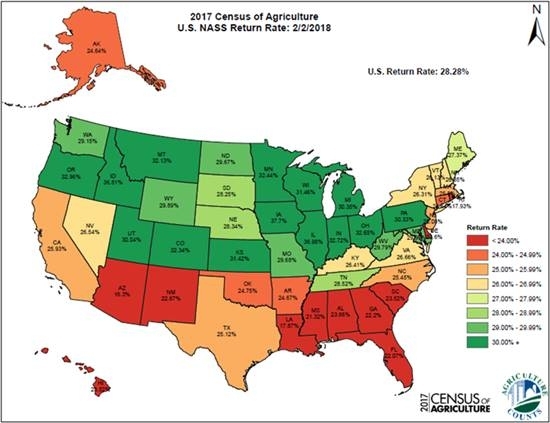
census map
The Citrus Research Board and Growers
Funding of the Citrus Research Board is an investment in pertinent research that supports the industry, making the information accessible to all within the industry from pest control advisors to packing houses to farm managers and others within the industry. The goal is to get the research done and then make sure it is used. CRB represents both large and small growers throughout California.
CRB research programs are funded by grower assessments which attract both federal and state funding, funding which represents a third of the total budget. This funding is used to support such projects as, HLB-resistant citrus rootstocks; the development of effective, low-cost HLB early detection technologies to rapidly remove infected trees; improved biocontrol methods for specific insect control like Asian citrus psyllid, as well as others; pre-and post-harvest citrus research to maintain export markets, amongst many other research programs.
The Citrus Research Board also supports the Citrus Clonal Protection Program (CCPP) with the goal of insuring the safe introduction of citrus varieties, disease diagnosis and pathogen elimination of introduced varieties and the maintenance and distribution of introduced varieties. CCPP serves as the primary source of clean, disease-free budwood and new varieties from Florida. This work is a collaboration between the Citrus Nursery Board, the University of California and State and Federal Regulatory agencies. The CCCP has become a major hub of the National Clean Plant Network for Citrus, resulting in the collaboration with 10 citrus centers in nine states and territories with multimillion dollar funding in support of CCCP's operations.
CRB research supports the California Citrus Quality Council (CCQC) with the primary objective of ensuring that California citrus meets domestic and international phytosanitary, food safety, food additive and pesticide residue regulations. CCQC ensures that California citrus growers have access to export markets for their fresh citrus fruit. Exports represent a third of the California citrus grower profits.
CRB-funded research into the California citrus-breeding program has led to the development of the Tango mandarin, along with others. The core breeding program conducts yield trials throughout the state on all varietal types to give growers information on upcoming new varieties and rootstocks. There is ongoing work to incorporate molecular tools to expedite breeding efforts to find plant materials resistant to HLB.
Along with CRB funding for cutting-edge projects for pest and disease control strategies, the CRB-funded CORE IPM Program led by Beth Grafton-Cardwell has responded to citrus grower needs for modifying existing spray schedule to treat Asian citrus psyllid. The program evaluates rotational sprays at appropriate times to avoid pesticide resistance to ACP.
Finally, this CRB-packaged information has been extended to growers through programs, including: The California Citrus Conference, Post-Harvest Conference and Seminar, and Regional Grower Education Seminars. CRB-funded research is compiled in Citrograph Magazine, the only magazine dedicated solely to the California citrus industry.

citrus and mountains
Attention Citrus Growers: Live Asian Citrus Psyllid fogging demonstration - FREE
The California Citrus Research Board (CRB) will be hosting a live Asian citrus psyllid (ACP) fogging. Demonstration will carried out by CRB Researcher, Dr. Spencer Walse.
The demonstration will involve placing ACP throughout t he citrus load in within the bins. Once the tent is sealed the fogger will be turned on (sit for 2 hr) and viles with the ACP will be relocated to show the percent mortality. Previous run of the experiment have been successful.
There will be 2 opportunities to view the demonstration:
Everyone is welcome! Hope to you there!
For more information: Sonia Rios, UCCE Famr Advicor- Riverside/San Diego County
951-683-6491 EXT 224
(Photos were taken at the live demonstration in Riverside County on 4/6/2017)

Semi-truck leaves the load in the portable fumigant tent
Community Educators Gather in Hopland
Community Educators representing the state wide Research and Extension Centers System (RECS) sites gathered February 25-27 in Hopland. The meeting was an opportunity for many of the educators to meet for the first time. A chance to network and develop...

Researchers wanted for Hopland Green House!

Innovative evapotransporation study is explained to group

Rodrigues points out the difference between grazed land and non grazed land

Vernal pools

Lambing pens

Lambing generally occurs between November and February

nursing lamb

Sheep

Hopland maintains sheep flock that graze the majority of the Center's rangelands

sheep at day break

Hannah's babies, adopted and bottle fed will become part of the youth education programs at the Center

barn 2

Acorns in the Oaks-the Center supports more than 215 species of wild birds

Grass, wood-land, dense woodland, and chapparral are found at Hopland REC including more than 600 plant species

